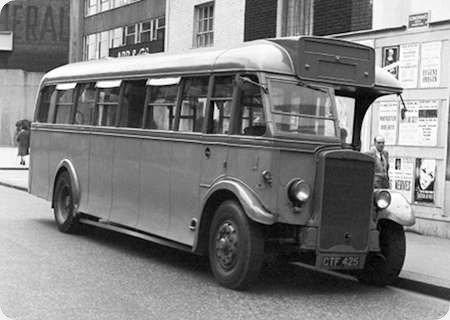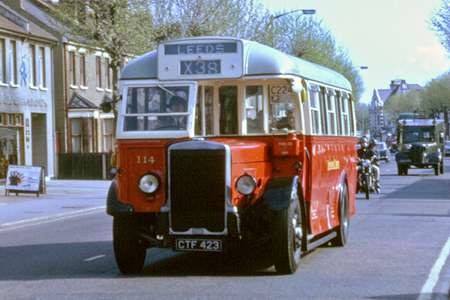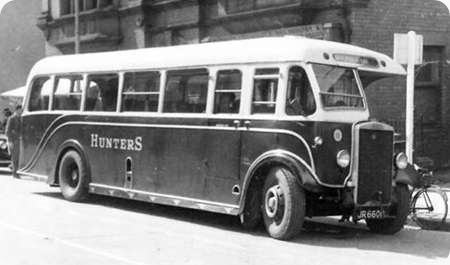
Photograph by ‘unknown’ if you took this photo please go to the copyright page.
H W Hunter and Sons
1937
Leyland Tiger TS7
Burlingham B35F
Another from H W Hunter and Sons. New to them in 1937, JR 6600 was a B35F Burlingham bodied Leyland TS7.
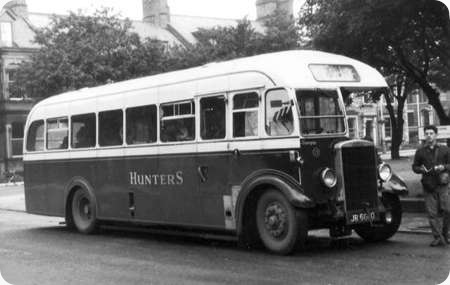
Photograph by ‘unknown’ if you took this photo please go to the copyright page.
In 1954 it was rebodied by Roe as a B39C, so it was around at the same time that they had the two Titans previously featured on this site. I’m 90 per cent sure they had another Leyland single decker but I’ve been unable to trace it. They had a well deserved reputation that you could virtually set your watch by Hunter’s bus and in addition to the service vehicles they had several coaches, all either AEC or Leylands, although they later switched to Volvo’s. They escaped becoming part of NBC and the formation Tyne and Wear PTE didn’t seem to affect them much because their depot and most of their single route were outside the area controlled by the PTE, so they were more or less allowed to continue much as before. However, I think the PTE may have had some influence over the decision to extended the route from North Shields beyond Seaton Delaval to Cramlington. The huge operational area covered by the pre NBC United Automobile Services empire was split up into bite size pieces prior to deregulation, and the area between the Tyne and the Scottish border was taken by the newly formed Northumbria Motor Services, which was in effect a management buyout. I don’t know the circumstances and I wouldn’t want to speculate, but Hunter’s became part of the Group. I think the name lived on for a while, but Northumbria Motor Services were swallowed up by Arriva, and like many other independents the name of W H Hunter is now, just a memory.
Photograph and Copy contributed by Ronnie Hoye
02/01/13 – 07:50
That is a huge seating capacity for a pre-war halfcab chassis. Was it extended when it was rebodied?
Eric Bawden
02/01/13 – 09:06
I wondered the same thing, Eric, and whether it was a road-based prototype for the "economy class" of airline seating!
Pete Davies
02/01/13 – 16:53
A most interesting question and 39 does seem a lot of seats in a vehicle of , presumably, 27’6" length. One would also have thought that a centre doorway, as opposed to the previous front door, might well reduce the available seat space. However, as the two pictures are taken from roughly very nearly the same perspective the vehicle appears to be the same length in both. It was unusual, but not unknown, for normal length prewar buses to have more seats than ideal space wise, but even the lightweight Lions and Cheetahs taken over by Samuel Ledgard in 1943 from the widow of G.F.Tate of Leeds originally seated 39 in their delightfully "old fashioned" Barnaby bodies.
Chris Youhill
02/01/13 – 17:35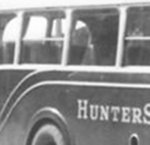
I’ve given all the information I could dig up and I don’t know if the chassis was extended, but two things look a bit odd to me. On the Burlingham body, if you look at the seat above the letter ‘H’ it gives the impression that the seats over the rear axle appear to be facing each other, also the wheels are fairly flush to the side of the vehicle, whereas on the Roe they look to be slightly inboard, as if the vehicle has been widened but the axle length is still the same, or is it me?
Ronnie Hoye
03/01/13 – 06:42
7ft 6in chassis and original body, but 8ft new body, perhaps? If so, this wouldn’t be the only one, and they do look a bit strange!
Pete Davies
03/01/13 – 06:43
Ronnie, I would agree with you that the Roe body looks to be 8ft on a 7ft 6in chassis. The Roe body also has an extra window bay to the Burlingham.
It may be purely body style but the body overhang behind the rear axle looks to be longer on the Roe than the Burlingham, certainly, there are almost two full window bays behind the wheelarch on the Roe as against one and a half on the Burlingham. Also if you look at the exhaust tailpipe it appears to be in the same position in relation to the back axle in both photos yet the Roe overhang, again seems to be longer.
Don’t know if it has anything to do with this discussion but the front wheels, despite the absence of nutguard rings on the Roe are different to those fitted in the Burlingham picture.
As this body looks to be almost identical to the centre entrance Guys placed in service with Darlington in 1952/3 I wonder if Hunter’s body was tagged on to the end of the Darlington order, a not uncommon occurrence at Crossgates Works, even into the ’70s. I believe Darlington’s Guys were B41C.
Has anyone a nearside view of this bus with its Roe Body?
Eric Bawden
03/01/13 – 06:44
My word Ronnie, I think you’ve hit on two very pertinent features there for sure. As regards the "inset" appearance of the wheels on the newer Roe body I would say that the replacement coachwork is eight feet wide on the unaltered 7’6" TS7 chassis – a practice not unknown in the 1950s especially on single deckers. Your enlargement of the area above the "H" of Hunters reveals an interesting feature. The "A" shaped seat back appears to be a joint support for two seats, one on the left facing backwards and sharing the floor space with a forward facing seat to its rear, and one forward facing one on the right. The four passengers (plus four on the nearside) in the facing seats no doubt had to put their feet on the slightly intruding wheel arches. What a wonderful vehicle in both its forms !!
Chris Youhill
03/01/13 – 06:44
To my eye the newer body looks longer, though not much – the typical Roe high domed roof tends to mask this. 39 seats would mean 10 rows on the offside, 9 on the nearside (both including the rear 5-some). That sounds awfully tight in a length of 27’6" – minus the length of the cab and thickness of the front bulkhead.
Stephen Ford
04/01/13 – 06:45
Eric, I typed JR 6600 into my search engine, and up came the Park Royal vehicles site with what I take to be a pre delivery photo taken outside the Roe works. It differs slightly from the Darlington Guy’s, as when the doors are closed they form part of the side of the bus, whereas the platform steps are exposed on the Darlington vehicles.
Ronnie Hoye
04/01/13 – 17:43
Thanks Ronnie. After initial difficulty I eventually found the photo on the PRV site.
Eric Bawden
08/01/13 – 07:43
Noting some of the concerns about fitting 39 seats into a body on a 27’6" chassis so earlier today I took a tape measure to a 1952 Roe body with 39 seats although in an overall 30′ chassis and with a front entrance.
Putting 5 seats across the rear leaves a further 34 seats to be fitted by means of 9 sets of double seats on the offside and a further 8 sets with a door on the nearside. The length of the 30 footer from the bulkhead to the rear of the final pair of seats at the back was 22’2" with a gap of 29.5/30" between the same points on adjoining seats.
Turning to the shorter 27’6" bus under review and allowing the same distance from the front of the bus to the front bulkhead and similar requirements for the rear seats leaves circa 19’6" for the 9 sets of seats on the offside and would allow a gap of just 25" between the same point each set of adjoining seats. To me that looked a rather tight fit so I measured the seat gaps on some others from that era and all of them were in the range of 28-30"
To reduce the gap between seats by 5" in the 1950’s would, in my opinion, require smaller seat bases or otherwise it would be impossible to fit your legs in.
Andrew Beever
08/01/13 – 10:42
Andrew: Although I agree that the extra seats would be tight, your maths isn’t quite right. With a 39 seater there are 10 rows of seats on the offside, including the back bench seat. On the basis of your 29.5" pitch, the overall length of the 10 rows is 295". Reduce this by 30" and the ten seats now have to fit 265", so the pitch is 26.5". You lose 3" per seat, rather than your 5". I am over 6 ft, with long legs, and can just make a 27" pitch with a thin seat back with my legs straight, so the average person just about fits OK. Birkenhead used to cram 66 seats onto a PD2 without a 3 seater at the back or a television seat. Those seats were definitely tight for me, and probably similar in pitch to 39 on a 27ft 6in half-cab.
Alan Murray-Rust
08/01/13 – 13:43
Alan, I had specifically excluded the rear seat in my calculations since this seat is effectively fitted into the rounded rear corners with very limited foot room under it.
Andrew Beever
15/01/13 – 16:38
Hunter 21 (JR 6600) had Roe body GO3827 when rebodied 3/54.
Hunter 20 (JR 4901) was the other Leyland TS7 10076 rebodied by Roe in 4/53 (GO3680) also squeezing in 39 seats in its centre entrance body.
Hunter did, of course, have another new Roe body. Fleet number 30 was WTY 843J, a Leyland PDR1A/1R, with H43/29D bodywork
MikeB
16/01/13 – 10:48
Thanks for that, Mike, I’ve been racking my brains, or rather what little is left of them. I knew they had a second Tiger but I’ve been unable to find any records of it, did that also start life with a Burlingham body?
Ronnie Hoye
27/01/13 – 10:30
I’m sure the two single deckers were VTY 360. & TJR 573 this I have to say is from memory many years ago.
Bob Mandale
28/01/13 – 08:40
Bob, MikeB came up with the answer I was looking for. The two single deck buses you refer to were the replacements for JR 4901 and 6600. They were AEC 2MU3RV’s with Plaxton Highwayman B45F bodies. TJR 573 was delivered in 1961 followed by VTY 360 in 1962 (VTY 360 is coming as a separate posting soon). By that time the chassis on 6600 was nigh on 25 years old and from the registration I would estimate 4901 to be a couple of years older. Apart from WTY 843J mentioned by MikeB, I believe the two AEC’s were the last new service buses bought by Hunter’s as all subsequent vehicles were either coaches or D/P’s
Ronnie Hoye
03/04/15 – 05:31
Further to the discussion on the length of JR4901 and JR6600, can I mention that these two vehicles had a rear-facing seat for five across the front bulkhead, and an inward facing single seat on the nearside just ahead of the centre entrance. I also think that the entrance may have been slightly wider than usual for a single decker of that era. I don’t recall the seat spacing as being especially tight, so I would think that the bodies must have been slightly longer than the original ones. Incidentally, the original body above is described as B34F, but it looks to me to be a coach body.
John Gibson
01/06/15 – 07:20
There was a heck of a lot of rebodying of half cab single deckers from 1950 as 38 or 39 seaters once the 27′ 6" maximum length had been increased to 30 feet.
However, all is not what it seems. Buses for Trent, North Western and Potteries and the Hunter’s Tiger were lengthened without any alteration to the wheelbase of 17′ 6" because the C&U Regs until 1961 allowed the rear overhang to be up to 50% of the wheelbase. With a front overhang of about 2′ 3" on, say, Gardner 5LW or AEC 7.7 engined chassis – and a rear overhang of 8′ 9" it was legal from 1950 to go to a maximum length of 28′ 6" without altering the wheelbase. This was sufficient for another row of seats to be fitted without any alteration of the chassis.
Indeed, I think it was only Yorkshire Woollen District which actually lengthened the wheelbase of its Willowbrook bodied PS2s to 18′ 9" when they lengthened them to 30 feet.
Many of the Leyland PS’s taken over by Potteries in the early fifties were already 28′ 6" long and may have inspired PMT to rebuild its Weymann single deck 17′ 6" wheelbase OPD2s by substituting a 2′ 7" long bay for a possible rear door with a 3′ 7" long standard window bay, increasing the seating capacity in the process.
Alan Johnson
